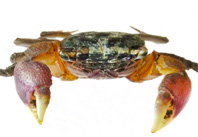Abstract
Amplaria nazinta (Chamberlin, 1910) is redescribed from freshly collected male specimens and its identity as a species of Amplaria Chamberlin, 1941 is confirmed. We amend the diagnosis of Amplaria, and for the first time report the presence of a limbus in a chordeumatidan millipede.
References
Bollman, C.H. (1888) Notes upon a collection of myriapoda from east Tennessee, with description of a new genus and six new species. Annals of the New York Academy of Sciences, 10, 106–112.
Causey, N.B. (1958) New records and descriptions of a new genus and species of millipeds of the family Striariidae (Chordeumida). Proceedings of the Biological Society of Washington, 71, 179–184.
Causey, N.B. (1960) Speostriaria, new genus. Proceedings of the Biological Society of Washington, 73, 25–28.
Chamberlin, R.V. (1908) Animal names and anatomical terms of the Goshute Indians. Proceedings of the Academy of Natural Sciences of Philadelphia, 60, 74–103.
Chamberlin, R.V. (1910) Diplopoda from the western states. Annals of the Entomological Society of America, 3, 233–262.
https://doi.org/10.1093/aesa/3.4.233Chamberlin, R.V. (1941) New western millipeds. Bulletin of the University of Utah, Biological Series 6, 31 (12), 3–23.
Loomis, H.F. (1936) New millipeds of the American family Striariidae. Journal of the Washington Academy of Sciences, 26, 404–409.
Means, J.C., Francis, E.A., Lane, A.A. & Marek, P.E. (2015) A general methodology for collecting and preserving xystodesmid and other large millipedes for biodiversity research, Biodiversity Data Journal, 3, 1–7.
Schmidt, D. (1962) Über die taxionomische Wertikeit von Strukturen des Metazonit-Hinterrandes bei Diplopoden. Senckenbergiana biologia, 43, 65–80.
Shear, W.A. & Krejca, J.K. (2007) Revalidation of the milliped genus Amplaria Chamberlin 1941 (Diplopoda, Chordeumatida, Striariidae), and description of two new species from caves in Sequoia and Kings Canyon National Parks, California. Zootaxa, 1532, 23–29.
Trimble, D.E. (1963) Geology of Portland, Oregon and adjacent areas: A study of tertiary and quaternary deposits, lateritic weathering profiles, and of quaternary history of part of the Pacific Northwest. Geological Survey Bulletin 1119. United States Government Printing Office, Washington, 119 pp.

